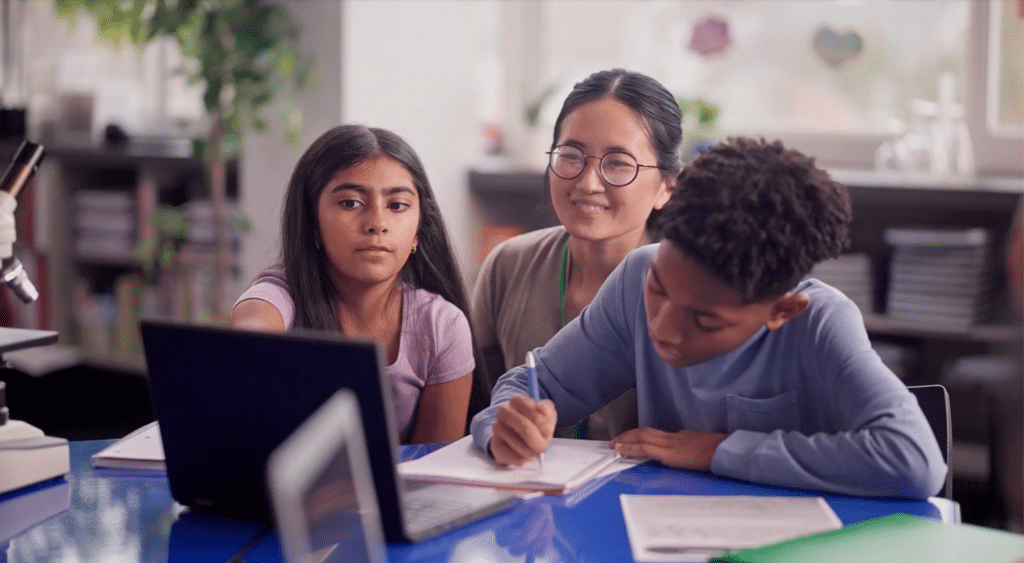Substitute teacher strategies for working with students with disabilities.

As a substitute teacher, understanding best practices for working with students with disabilities will help you provide all students with the support they need to do their best.
About 7.3 million students in the United States qualify for special education supports and services—that’s about 15% of students.
Dr. Kathleen Adolt-Silva, Director of Special Education content at Kelly Education, is a leading expert on strategies for working with students with disabilities. She works to provide our educators with resources to make sure outcomes are achieved. Adolt-Silva uses the ADAPTABLE acronym in her seminars as a best practice for teaching and supporting students who qualify for special education services:
ADAPTABLE strategies for working with students with disabilities:
- Acquaint yourself with the information.
- Deliver legally required accommodations and modifications.
- Adhere to routine.
- Provide positive reinforcement.
- Team collaboration is important for success.
- Assess progress.
- Be prepared for health needs.
- Lead with inclusion and encourage participation.
- Ensure confidentiality.
What qualifies a student to receive special education services?
According to United States law, a disability is any condition of the mind or body that makes it more difficult for the person with the condition to do certain activities or interact with the world around them.
To qualify for special education services, a team of professionals, the child’s parent(s), and often the child themselves work together to determine whether the student has a disability that significantly impacts their ability to access their education, requiring individualized support services. Every student who qualifies for special education services in the United States must have an individualized education plan, or IEP, designed to support their unique needs.
As a substitute teacher, you will have students with IEPs in your classroom. You likely will not be aware of which students in your classroom have IEPs. When working with provides supports and services to students within a standard classroom environment whenever possible.
ADAPTABLE strategy for working with students with disabilities.
As a substitute teacher, being ADAPTABLE can help you utilize strategies for working with students with disabilities.
Acquaint yourself with the information.
Look for accommodation or modification sheets, notes from the teacher on individual student routines, school-wide and class-wide behavior management methods, and the class schedule when you enter the classroom.
Deliver legally required accommodations and modifications.
Accommodations change how a student can access instruction or demonstrate proficiency, but don’t change what they’re expected to do. Modifications change what the student is expected to learn.
Accommodations can include providing extended time for tests, offering a written list of instructions for classroom activities, providing specialized instruction on study skills, offering frequent breaks, and much more.
Modifications might include offering alternate projects or assignments, being excused from certain subjects, or grading on a pass/fail scale instead of a standard grade scale.
Adhere to routine.
Try to follow the student’s daily schedule as much as possible and use prescribed behavior management methods as much as you can. Be sure that any assistive devices or materials are used, follow the classroom teacher’s lesson plan, and start the class with an overview of what students can expect throughout the class period or the day.
Provide positive reinforcement.
A gesture as simple as giving a student a thumbs up can help them stay on track. Providing consistent, specific, genuine praise for positive actions can create a positive classroom environment and reinforce positive behavior. When possible, compliment students for following classroom rules, and remind them that practice makes progress.
Team collaboration is important for success.
If you have a support staff member in your classroom, ask their name, introduce yourself, and communicate with them regularly. Understand their work schedule and talk with them about student needs (be sure to do so privately).
Assess progress.
You may be responsible for monitoring and documenting student progress while you’re substitute teaching. The classroom teacher might ask that you provide data on certain student academic or behavioral matrices.
Be prepared for health needs.
Some students with disabilities may have health conditions, physical movement limitations, or hygiene needs that require attention. You must assist students within the limitations of your training and refer to the school nurse or support staff for extensive health needs, such as physically moving students, diapering, or toileting. All Kelly Education, employees can help children with eating, drinking, and basic face and hand hygiene.
Lead with inclusion and encourage participation.
Use inclusive, person-first language. Offering multiple ways to participate—for example, allowing students to use software, encouraging the use of graphic organizers, and providing all materials in advance or in outline form can help students select the learning method that makes the most sense for their unique needs.
Ensure confidentiality.
In special education, confidentiality is important. When discussing a student, consider who is listening (or who could be listening), who is being discussed, where the discussion is taking place, and why the discussion is taking place.
Grow as a Kelly Education substitute teacher.
You’ll enjoy more in-depth coverage of how schools assist students with disabilities, how you can support students with disabilities as a substitute teacher, and how you can provide students with disabilities with the individualized support necessary for them to thrive.
If you want to explore another topic, we have an entire library of helpful articles for substitute teachers and paraeducators. To get started, check these out:
- Classroom management techniques
- Understanding IEP and 504 plans
- Complete guide to becoming a substitute teacher
Considering work in schools as a substitute teacher, tutor, or paraeducator? Fill out our brief interest form. One of our recruiters will be in touch with you to share more about the requirements and process to begin making a difference in the lives of children.

View Related: Article Career advancement
You might like
How to be a good substitute teacher.
5 minute read
How to be a good substitute teacher.
5 minute read
Find your next job
Discover thousands of temporary, full-time, and remote jobs for beginning and experienced job seekers.


